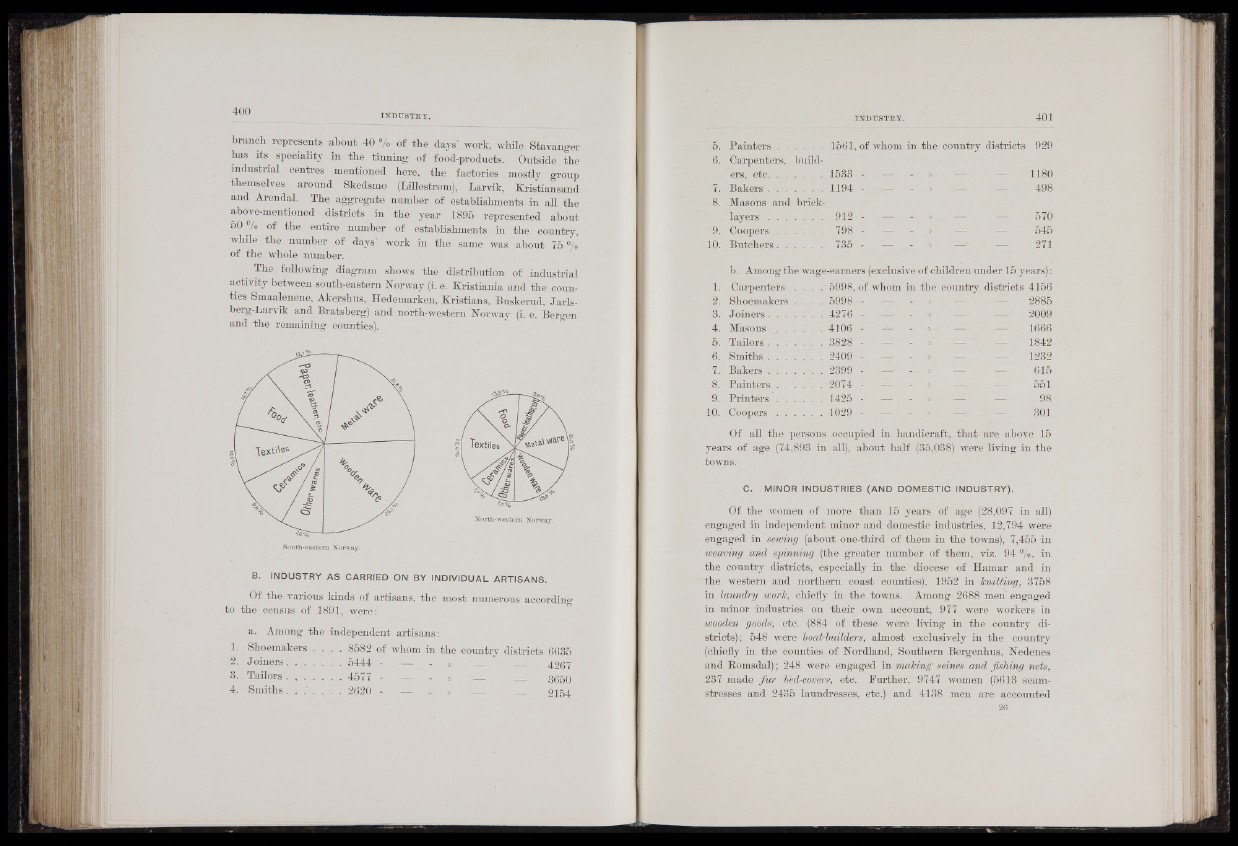
branch represents about 40 % of the days’ work, while Stavanger
has its speciality in the tinning of food-products. Outside the
industrial centres mentioned here, the factories mostly group
themselves around Skedsmo (Lillestrom), Larvik, Kristiansand
and Arendal. The aggregate number of establishments in all the
above-mentioned districts in the year 1895 represented about
50 % of the entire number of establishments in the country,
while the number of days’ work in the same was about 75 °/o
of the whole number.
The following diagram shows the distribution of industrial
activity between south-eastern Norway (i. e. Kristiania and the counties
Smaalenene, Akershus, Hedemarken, Kristians, Buskerud, Jarls-
berg-Larvik and Bratsberg; and north-western Norway (i. e. Bergen
and the remaining counties).
B. INDUSTRY AS CARRIED ON BY INDIVIDUAL ARTISANS.
Of the various kinds of artisans, the most numerous according
to the census of 1891, were:
a. Among the independent artisans :
1. Shoemakers . . . . 8582 of whom in the country districts 6635
'2. Joiners. / ............. 5444 - — •. '» 4267
3. Tailors 4577 »' - 3650
4. Smiths. . . ' . . . . 2620 - — - ». -_4_ 2154
5. P a in te rs..................1561, of whom in the country districts 929
6. Carpenters, builders,
etc 1533 - 9 %- » V' v ; — 1180
7. Bakers . ..............1194 - — - » — ' ^ “ 498
8. Masons and bricklayers
912 - — - » . — . — 570
9. Coopers................. 798 - 545
10. Butchers.-.. 735 - 'js B f e -,- » —v' ■ — . 271
b. Among the wage-earners (exclusive of children under 15 years) :
1. Carpenters . . . . 5998, of whom in the country districts 4156
2. Shoemakers . . . . 5998
2885
3. Joiners.................. 4276
2009
4. Masons _ . .............. 4106
1666
5. Tailors.................. 3828
1842
6. Smiths ’. . 2409
1232
7. Bakers.................. 2399
615
8. P a in te rs 2074
551
9. P r in te r s ..................1425
98
10. Coopers . . . . . . 1029
301
Of all the persons occupied in hand aft, that are above 15
years of age (74,893 in all), about half (35,038) were living in the
towns.
C. MINOR INDUSTRIES (AND DOMESTIC INDUSTRY).
Of the women of more than 15 years of age (28,097 in all)
engaged in independent minor and domestic industries, 12,794 were
engaged in sewing (about one-third of them in the towns), 7,455 in
weaving and spinning (the greater number of them, viz. 94 %>, in
the country districts, especially in the diocese- of Hamar and in
the western and northern coast counties), 1952 in knitting, 3758
in laundry work, chiefly in the towns. Among 2688 men engaged
in minor industries on their own account, 977 were workers in
wooden goods, etc. (884 of these were living in the country districts);
548 were boat-builders, almost exclusively in the country
(chiefly in the counties of Nordland, Southern Bergenhus, Nedenes
and Romsdal); 248 were engaged in making’ seines and fishing nets,
237 made fu r Ved-covers, etc. Further,' 9747 women (5613 seamstresses
and 2435 laundresses, etc.) and 4138 men are accounted
26